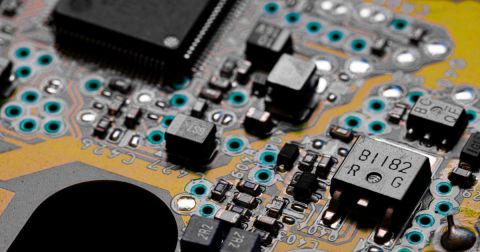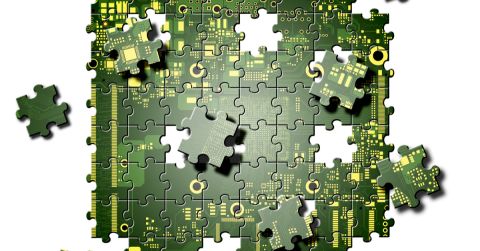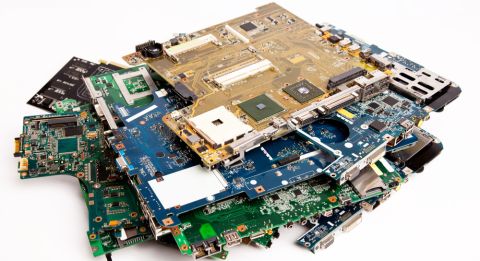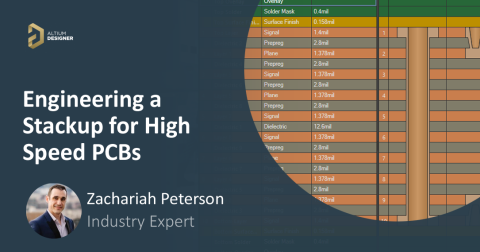How Does Dispersion in FR4 Really Affect Propagation Delay?

Long ago, when I was working in a lab on optoelectronic semiconductor devices, the prototypes we built were pretty messy. Rather than splurge on top-quality materials, we used standardized, low-cost materials and measurement instruments just to get our devices to work. The devices did work, and all we sacrificed was aesthetics. But when it came time to show the feasibility of our devices in real applications, we knew we had to work with the right high-purity materials.
There are tradeoffs in choosing between a cheaper, more popular material and an expensive, effective material. An FR4 substrate is the baseline standard for any PCB designer to start building a circuit board, and it pays to know more about how FR4 dispersion affects signal integrity and propagation delay in your PCB.
FR4 Material and High-Speed/High-Frequency Design
FR4 materials are a broad class of glass-weave resin-impregnated materials that are used as a PCB substrate. When some online references state a value for the dielectric constant of FR4, they state this as a fixed value or limited a specific range (usually 4 to 4.8). So which is correct? The correct answer is: it depends on frequency!
All materials in nature exhibit dielectric dispersion, or a change in the dielectric constant of a material with frequency. In other words, waves traveling in a material with different frequencies will travel at different speeds. This fact may not be stated clearly in PCB material datasheets, and nearly all online impedance calculators can't account for dispersion in an FR4 substrate.
Why FR4 Dispersion Matters
Those familiar with high-speed design know that trace geometry, trace location, and board substrate all affect signal speed, impedance matching, and propagation delay. Dispersion is sometimes overlooked for a number of reasons. Today's digital designers often work in the time domain, so they focus on tailoring the digital response in a high speed channel. Analog designers often work at a specific frequency or in a limited bandwidth, so they often approximate to a single frequency.
- Impedance calculations: Dispersion in FR4 materials needs to be considered for highly accurate impedance calculations in high speed and high frequency design. If you apply the value at 100 MHz to 10 GHz, you won't get the same impedance and it's possible to incorrectly size the traces.
- Propagation constant calculations: Thanks to transmission line theory, the impedance is also related to the propagation constant of the signal, which then determines the amount of loss a signal sees. Loss also varies with frequency, leading to signal distortion in longer channels.
- Critical length calculations: All interconnects have a critical length that determines the transition to transmission line behavior. Dielectric dispersion causes different frequencies to have different critical lengths where impedance matching starts to become important.
An accurate calculation of impedance and loss is critical for determining whether an FR4 substrate is the best option as traces on FR4 have higher losses than on other RF-specialized materials above 1 GHz. In many instances, some other material may be better used as a substrate for high-frequency/high-speed devices. Examples where an alternative low-loss material is needed include backplanes, networking equipment with copper media, and expansion cards.
Dielectric Dispersion and Your Interconnects
The astute interconnect designer is probably thinking "interconnects already have dispersion at low frequencies, so why are we worried about dielectric dispersion?" It is true that the parameters in the RLCG model create dispersion due to the structure of a transmission line. Note that this is in addition to dispersion caused by copper roughness along an interconnect.
At lower frequencies, the propagation constant is quite different from the value at higher frequencies. When you add to this the dielectric dispersion from the FR4 substrate, you have additional dispersion in the propagation constant that does not disappear at high frequencies. We can see this if we look at a limit for the general form of the propagation constant, where the interconnect capacitance is written in terms of a geometric factor (Kg) and the FR4 substrate dielectric constant:

Here, we see that, even at extremely high frequencies where the ideal transmission line model says there is no dispersion, we still have dielectric dispersion in the FR4 substrate. The propagation constant on a PCB trace depends on the dielectric constant of the substrate, the dimensions of the trace, and whether we are considering a stripline or microstrip trace.
Dispersion in Striplines vs. Microstrips
Striplines and microstrips experience different levels of dispersion from the FR4 substrate due to their location in the layer stack. In striplines, all field lines pass through air, so their strength is determined entirely by the FR4 substrate dielectric constant. For microstrips, the field lines from the conductor partially pass through air before they terminate at the nearby ground plane. This is why striplines and microstrips may need to have different widths to have the same impedance.
A microstrip's propagation constant is determined by a modified dielectric constant, called the effective dielectric constant. This is normally calculated by ignoring the effects of dispersion and absorption in the substrate. This is fine at low frequencies and switching speeds, but the same calculations yield the incorrect propagation delay at high frequencies and switching speeds.
There is a lot going on here with geometric dispersion vs. dielectric dispersion, but the effects of dispersion in an FR4 substrate can be summarized as follows: dielectric dispersion creates an additional source of signal distortion along an interconnect. To properly describe all effects of dispersion in an FR4 substrate, we need an accurate model to describe the dielectric constant of FR4 materials.
Calculating Dispersion in FR4 Materials
There are a couple general trends that are known about the dielectric constant of FR4 materials:
- At very low frequencies and low switching speeds, the propagation delay is relatively insensitive to frequency/switching speed changes. But propagation delay becomes more sensitive at higher speeds and frequencies, and where the differences arise depend on the type of interconnect.
- FR4 has negative dispersion and increasing loss tangent at increasingly higher frequencies. Compared to other materials that are specialized for high frequencies, dispersion actually increases the signal speed at higher frequencies, thus decreasing the propagation delay at higher frequencies.
- Electromagnetic absorption in FR4 rapidly increases up to about 100 KHz and then increases steadily up to about 100 GHz. This causes traces on FR4 to have larger attenuation at high frequencies for a given board thickness.
Accurate impedance and propagation constant calculations require an accurate model describing the dielectric constant of the substrate material.
Wideband Debye Model
This model is the best model for calculating the dielectric constant of a PCB substrate material. This model assumes purely linear behavior in the FR4 substrate with causality enforced. Using a Kramers-Kronig relation for the real and imaginary parts of the dielectric constant, we have the following infinite series describing the dielectric constant:

The coefficients for the wideband Debye model can be found in journal articles:
- Wideband Debye model derivation: Djordjevic, Antonije R., et al. "Wideband frequency-domain characterization of FR-4 and time-domain causality." IEEE Transactions on Electromagnetic Compatibility 43, #4 (2001): 662-667.
- Some data for striplines (N=2) and microstrips (N=1): Zhang, Jianmin, et al. "Planar transmission line method for characterization of printed circuit board dielectrics." Progress In Electromagnetics Research 102 (2010): 267-286.
The plot below shows a comparison of the real and imaginary portions of the dielectric constant in a stripline on a typical FR4 substrate.

This should show how propagation delay and loss appear at different frequencies: we have higher losses at higher frequencies, as seen from the imaginary part. The best layer stackup management tools can help you account for these aspects of the dielectric constant without any manual calculations.
There are plenty of challenges involved in selecting the best FR4 substrate and accounting for dispersion in FR4 materials. Today's designers trust the Layer Stack Manager in Altium Designer® to create PCB stackups and calculate impedance with an integrated field solver. Once you've finished your design and you need to share it with your design team or manufacturer, you can easily share your design using the Altium 365™ platform. Talk to an Altium expert today to learn more.











